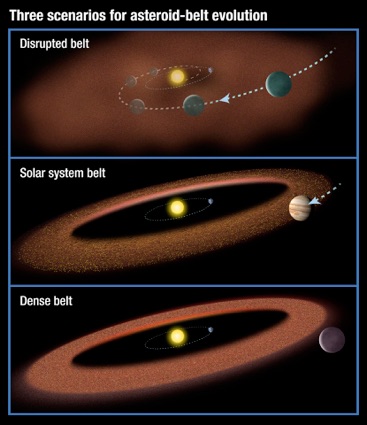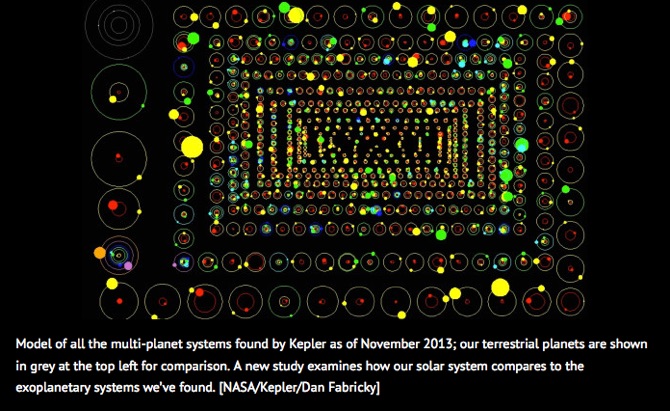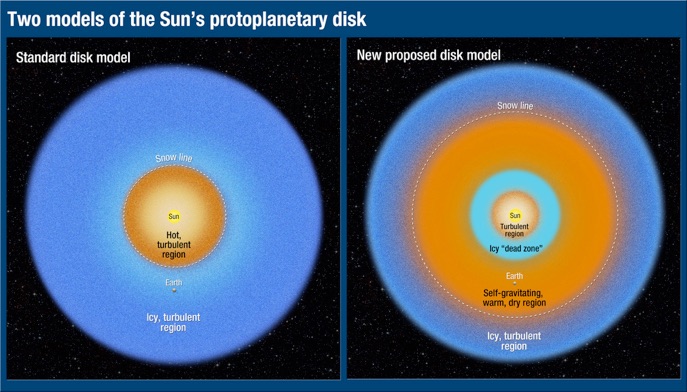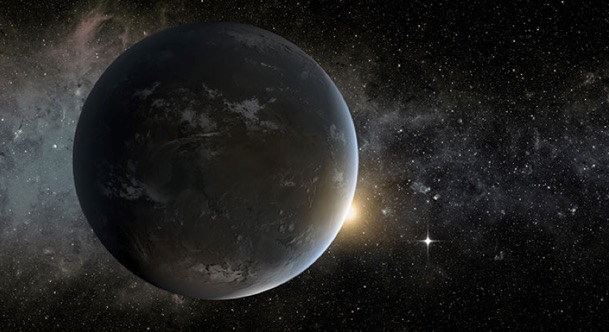Media

Our planet might not have always been the largest rock in the inner solar system.
Coverage from April 2016 on Inside Science.
Title: On the formation of super-Earths with implications for the Solar System
Rebecca G. Martin & Mario Livio, 2016, ApJ in press
Abstract: We first consider how the level of turbulence in a protoplanetary disk affects the formation locations for the observed close-in super-Earths in exosolar systems. We find that a protoplanetary disk that includes a dead zone (a region of low turbulence) has substantially more material in the inner parts of the disk, possibly allowing for in situ formation. For the dead zone to last the entire lifetime of the disk requires the active layer surface density to be sufficiently small, <100 g/cm^2. Migration through a dead zone may be very slow and thus super-Earth formation followed by migration towards the star through the dead zone is less likely. For fully turbulent disks, there is not enough material for in situ formation. However, in this case, super-Earths can form farther out in the disk and migrate inwards on a reasonable timescale. We suggest that both of these formation mechanisms operate in different planetary systems. This can help to explain the observed large range in densities of super-Earths because the formation location determines the composition. Furthermore, we speculate that super-Earths could have formed in the inner parts of our solar system and cleared the material in the region inside of Mercury's orbit. The super-Earths could migrate through the gas disk and fall into the Sun if the disk was sufficiently cool during the final gas disk accretion process. While it is definitely possible to meet all of these requirements, we don't expect them to occur in all systems, which may explain why the solar system is somewhat special in its lack of super-Earths.
Why is the earth so dry?
Press release from July 2012 here.
Title: On the evolution of the snow line in protoplanetary discs
Rebecca G. Martin & Mario Livio, 2012, MNRAS, 425, L6
Abstract: We model the evolution of the snow line in a protoplanetary disc. If the magnetorotational instability (MRI) drives turbulence throughout the disc, there is a unique snow line outside of which the disc is icy. The snow line moves closer to the star as the infall accretion rate drops. Because the snow line moves inside the radius of the Earth's orbit, the formation of our water-devoid planet is difficult with this model. However, protoplanetary discs are not likely to be sufficiently ionized to be fully turbulent. A dead zone at the mid-plane slows the flow of material through the disc and a steady state cannot be achieved. We therefore model the evolution of the snow line also in a time-dependent disc with a dead zone. As the mass is accumulating, the outer parts of the dead zone become self-gravitating, heat the massive disc and thus the outer snow line does not come inside the radius of the Earth's orbit, contrary to the fully turbulent disc model. There is a second, inner icy region, within the dead zone, that moves inwards of the Earth's orbit after a time of about 106 yr. With this model there is sufficient time and mass in the disc for the Earth to form from water-devoid planetesimals at a radius of 1 au. Furthermore, the additional inner icy region predicted by this model may allow for the formation of giant planets close to their host star without the need for much migration.
Asteroid belts of just the right size are friendly to life
Press release from November 2012 here.
Title: On the formation and evolution of asteroid belts and their potential significance for life
Rebecca G. Martin & Mario Livio, 2013, MNRAS, 428, L11
Abstract: Suggestions have been made that asteroid belts may be important both for the existence of life and perhaps even for the evolution of complex life on a planet. Using numerical models for protoplanetary discs, we calculate the location of the snow line, and we propose that asteroid belts are most likely to form in its vicinity. We then show that observations of warm dust in exosolar systems, thought to be produced by collisions between asteroids in a belt, indicate that asteroid belts (when they exist) indeed coincide with the radial location and the temperature of the snow line. Giant planets form outside the snow line and prevent planet formation just inside of their orbit, creating an asteroid belt there. However, the migration of giant planets through the asteroid belt likely disperses the compact formation. We examine existing observations of giant exoplanets and find that less than 4 per cent are at radial locations outside of the snow line. This definitely may be the consequence of observational selection effects. However, with this caveat in mind, we point out that the dearth of giant planets outside the snow line may also suggest that compact asteroid belts are not common, and more speculatively that complex life may not be expected in most of the currently observed systems.

How normal is our solar system?
Coverage from September 2015 on AAS Nova and New Scientist.
Title: The Solar System as an Exoplanetary System
Rebecca G. Martin & Mario Livio, 2015, ApJ, 810, 105
Abstract: With the availability of considerably more data, we revisit the question of how special our solar system is compared to observed exoplanetary systems. To this goal, we employ a mathematical transformation that allows for a meaningful, statistical comparison. We find that the masses and densities of the giant planets in our solar system are very typical, as is the age of the solar system. While the orbital location of Jupiter is something of an outlier, this is most likely due to strong selection effects toward short-period planets. The eccentricities of the planets in our solar system are relatively small compared to those in observed exosolar systems, but are still consistent with the expectations for an 8-planet system (and could, in addition, reflect a selection bias toward high-eccentricity planets). The two characteristics of the solar system that we find to be most special are the lack of super-Earths with orbital periods of days to months and the general lack of planets inside of the orbital radius of Mercury. Overall, we conclude that, in terms of its broad characteristics, our solar system is not expected to be extremely rare, allowing for a level of optimism in the search for extrasolar life.



Image credit:NASA Ames/JPL-Caltech/Tim Pyle | http://go.nasa.gov/1SEMRoh